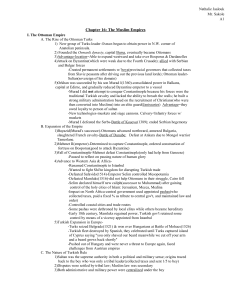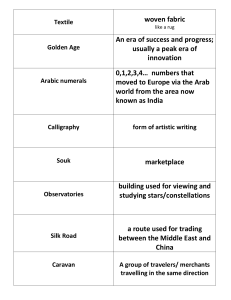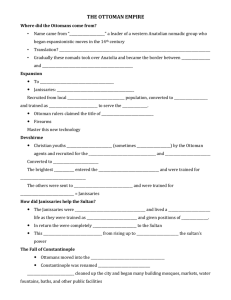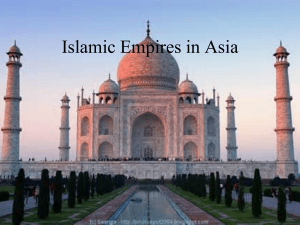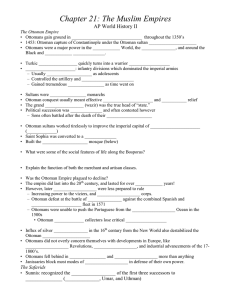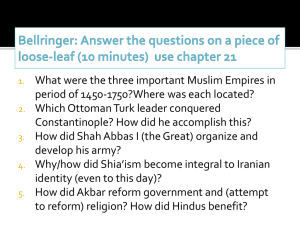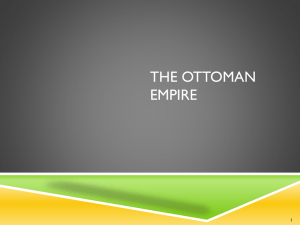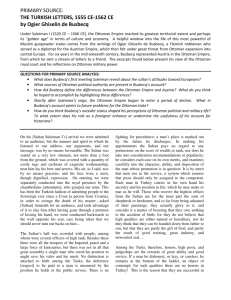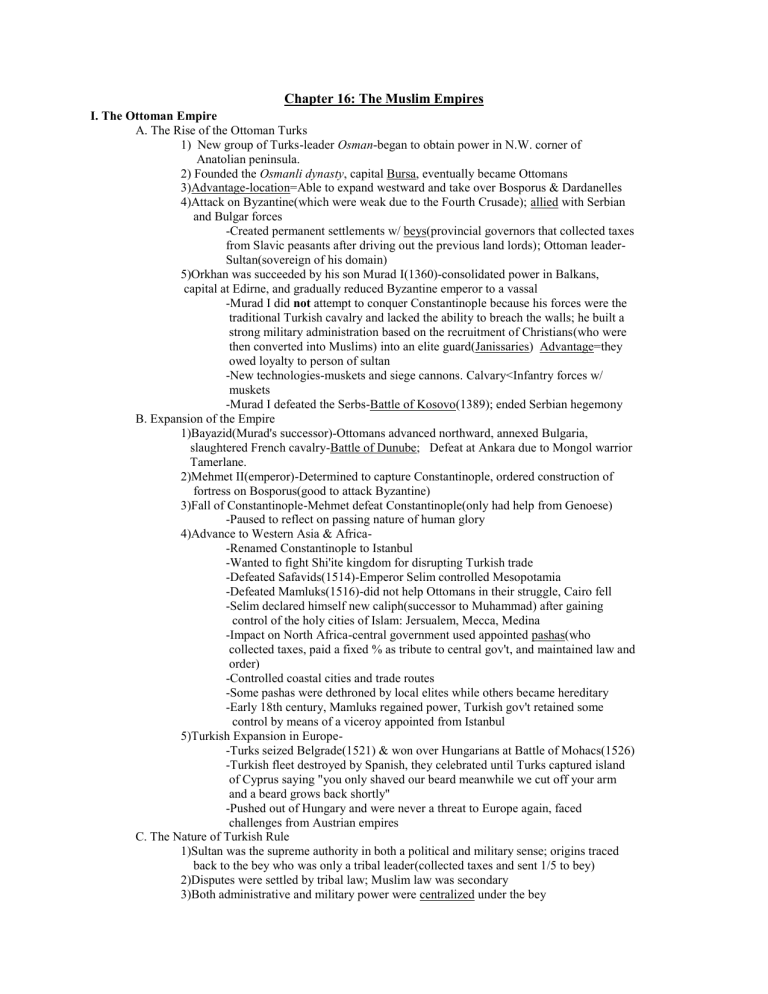
Chapter 16: The Muslim Empires I. The Ottoman Empire A. The Rise of the Ottoman Turks 1) New group of Turks-leader Osman-began to obtain power in N.W. corner of Anatolian peninsula. 2) Founded the Osmanli dynasty, capital Bursa, eventually became Ottomans 3)Advantage-location=Able to expand westward and take over Bosporus & Dardanelles 4)Attack on Byzantine(which were weak due to the Fourth Crusade); allied with Serbian and Bulgar forces -Created permanent settlements w/ beys(provincial governors that collected taxes from Slavic peasants after driving out the previous land lords); Ottoman leaderSultan(sovereign of his domain) 5)Orkhan was succeeded by his son Murad I(1360)-consolidated power in Balkans, capital at Edirne, and gradually reduced Byzantine emperor to a vassal -Murad I did not attempt to conquer Constantinople because his forces were the traditional Turkish cavalry and lacked the ability to breach the walls; he built a strong military administration based on the recruitment of Christians(who were then converted into Muslims) into an elite guard(Janissaries) Advantage=they owed loyalty to person of sultan -New technologies-muskets and siege cannons. Calvary<Infantry forces w/ muskets -Murad I defeated the Serbs-Battle of Kosovo(1389); ended Serbian hegemony B. Expansion of the Empire 1)Bayazid(Murad's successor)-Ottomans advanced northward, annexed Bulgaria, slaughtered French cavalry-Battle of Dunube; Defeat at Ankara due to Mongol warrior Tamerlane. 2)Mehmet II(emperor)-Determined to capture Constantinople, ordered construction of fortress on Bosporus(good to attack Byzantine) 3)Fall of Constantinople-Mehmet defeat Constantinople(only had help from Genoese) -Paused to reflect on passing nature of human glory 4)Advance to Western Asia & Africa-Renamed Constantinople to Istanbul -Wanted to fight Shi'ite kingdom for disrupting Turkish trade -Defeated Safavids(1514)-Emperor Selim controlled Mesopotamia -Defeated Mamluks(1516)-did not help Ottomans in their struggle, Cairo fell -Selim declared himself new caliph(successor to Muhammad) after gaining control of the holy cities of Islam: Jersualem, Mecca, Medina -Impact on North Africa-central government used appointed pashas(who collected taxes, paid a fixed % as tribute to central gov't, and maintained law and order) -Controlled coastal cities and trade routes -Some pashas were dethroned by local elites while others became hereditary -Early 18th century, Mamluks regained power, Turkish gov't retained some control by means of a viceroy appointed from Istanbul 5)Turkish Expansion in Europe-Turks seized Belgrade(1521) & won over Hungarians at Battle of Mohacs(1526) -Turkish fleet destroyed by Spanish, they celebrated until Turks captured island of Cyprus saying "you only shaved our beard meanwhile we cut off your arm and a beard grows back shortly" -Pushed out of Hungary and were never a threat to Europe again, faced challenges from Austrian empires C. The Nature of Turkish Rule 1)Sultan was the supreme authority in both a political and military sense; origins traced back to the bey who was only a tribal leader(collected taxes and sent 1/5 to bey) 2)Disputes were settled by tribal law; Muslim law was secondary 3)Both administrative and military power were centralized under the bey 4)Capital was wherever the bey and administration happened to be 5)Role of Sultan-Court rituals were inherited from Byzantine and Persians, and a centralized administrative system was adopted that increasingly isolated the sultan in his palace -Position of sultan was hereditary, with a son(not only the eldest) a) practice led to chronic succession struggles upon the death of individual sultans, losers were executed or imprisoned, potential heirs were assigned as provincial governors to provide them with experience 6)The Harem-Power of Sultan in Topkapi Palace(center of Istanbul); private domain of sultan is called harem -A sultan did not normally marry but he chose 7 concubines as his favorites and they were accorded this status after giving birth to his sons. When a son becomes sultan, his mother is known as the queen mother and served as adviser to the throne -Members of harem were slave origin; non-islamic people -Some concubine were trained and educated in a system called devshirme, they were ranked in status -UNIQUE=exclusive use of slaves to reproduce its royal heirs -Women had much political power D. Religion and Society in the Ottoman World 1) Religious tolerance, non-muslims had to pay head tax 2) Millets(religious group of administration) had their own justice system and stuff 3)"Urban residents"-peasants, artisans, merchants 4) Taxes based on amount of land the peasants owned and were paid to the local sipahis 5)Merchants were the most privileged class-large exemption from gov't regulations and taxes -made high prices with monopolies 6) WOMEN-own/inherit property, no forced marriage, seek divorce E. Ottomans in decline 1) Ottoman high peak-under Suleyman the Magnificent 2) Meritocratic administrative elite ---> privileged and hereditary caste 3) Inflation, decline in gov't, impact of Western customs, increasing degree of material affluence F. Ottoman art 1) Architecture-domes, painted tiles; Textiles-silks and rugs II. The Safavids A. Rise-founded by Shah Ismail, peak under Shah Abbas because he established a system to train administrators to replace the traditional warrior elite; used peace period to strengthen army B. Collapse-succession conflicts; Iranian women that had freedom were now forced into seculsion; minorities were at a state of unrest; collapsed in 1723 being corned by Ottomans C. Politics & Society-influence from surrounding areas, most people were farmers,Shi'ite=Unifying force; The shah had a divine quality and claimed to be spiritual leader of Islam; Shi'ism=state religion; landed aristocracy but their power was controlled by shahs; to avoid competition-hired foreigners to gov't positions -Shahs engaged in economy; provided accomodations for travelers -They had no navy and were forced to overland trade-Brocades, carpets, and leather were highly prized D. Art & Literature- Imitating Chinese , largely ignored traditional Persian designs on the ceramics; silk weaving and carpet making;painters began to highlight the inner character of their subjects III. The Grandeur of the Mughals A. Babur rose to power by helping a dynasty against its opponents, used elephants, charismatic personality and vigor B. Religion & State-religious tolerance(he married a hindu princess); he patronized classical arts; abolished many Hindu restrictions in a Muslim-dominated society(Akbar)------Over his years, he became for hostile to Islam; he sponsored a new form of worship=Divine Faith(combined characteristics of several religions with a central belief in the infallibility of all decisions reached by the emperor) Fell apart after he died C. Administrative reforms-divided into province; central government;local officials(zamindars) had to forward the taxes to gov't; punishments were mild D. Harmony=ideal social order, each individual and group within the empire would play their assigned role and contribute to the welfare of society as a whole(Based on his vision of laws shaped by Islam, belief in importance of class hierarchy, caste system), Akbars rule was peaceful E. Foreign trade, textiles tropical food products, spices, and precious stones were exported in exchange for gold and silver F. Succession-Jahangir(son) strengthened control but gripped weakened and the court fell under the influence of one of his wives(Null Jahan) who took advantage of her position to enrich her family and set a marriage up for her niece and ultimate successor, Shah Jahan -Shah Jahan ordered the assassination of all of his rivals; majority of his subjects lived in poverty; had to raise taxes for campaigns; moved capital from Agra to Delhi and built RED FORT and TAJ MAHAL -^his sons fought for power; Shikoh was too violent and lacked political acumen and was outmaneuvered by Aurangzeb -Aurangzeb-reversed religious tolerance; Hindu poll tax restored; no new Hindu temples; forced conversions to Islam; all of this led to unrest and revolts broke out against imperial authority G. Collapse of Mughal empire-draining of the imperial treasury and the decline in competence of the Mughal rulers H. The empire was less a centralized state than a loosely knit collection of heterogenous principalities held together by the authority of the throne I. As local elites increased their wealth and influence, they became less willing to accept the authority and financial demands from Delhi IV. Impact of European Power in India A. European merchants focuses on taking part in the carrying trade between one Asian port and another B. English fleet-->Surat : rejected but they kept persisting and finally got to install their own ambassador at the imperial court in Agra C. Dutch abandoned their interests in India to concentrate on spice trade but not the French-had a successful fight with British until Sir Robert Clive showed up-Clive consolidated British control in Bengal; British began to consolidate their economic and administrative control over Indian territory through the surrogate power of the powerless Mughal court SIG-major step in the gradual transfer of all of the Indian subcontinent to the British East India Company and later the British crown D. The company's takeover was a disaster for the Indian economy=resulted in the transfer of capital from the local Indian aristocracy to company officials and it hastened the destruction of once healthy local industries and British expansion hurt the peasants E. Resistance to the British-Indian commanders avoided pitched battles with the British but harassed and ambushed them in the manner o guerrillas in our time V. The Mughal Dynasty: A "Gunpowder Empire" A. Mughals created an empire that appeared highly centralized from the outside but was actually a collection of semiautonomous principalities ruled by provincial elites and linked together by the overarching majesty of the Mughal emperor B. Cultures-Mughals combined Muslim with Hindu and even Persian concepts and cultural values in a way that represents the greatness of the Indian civilization=Sikhism; benefited from the mood of syncretism promoted by the Mughal court C. WOMEN-all castes were expected to spinning thread; own land; business activities D. Architecture-Humayun's mausoleum=Persian + Islamic motifs in a building; technique of creating floral mosaics may have been brought by Italian artists in the court; Painting-"Akbar Style" combined Persian with Indian motifs(use of extended space and portrayal of humans engaged in physical action) E. Literature-poems written in Persian style; new language-Urdu for court and poetry; revival of devotional literature(mainly to Krishna and Rama)
